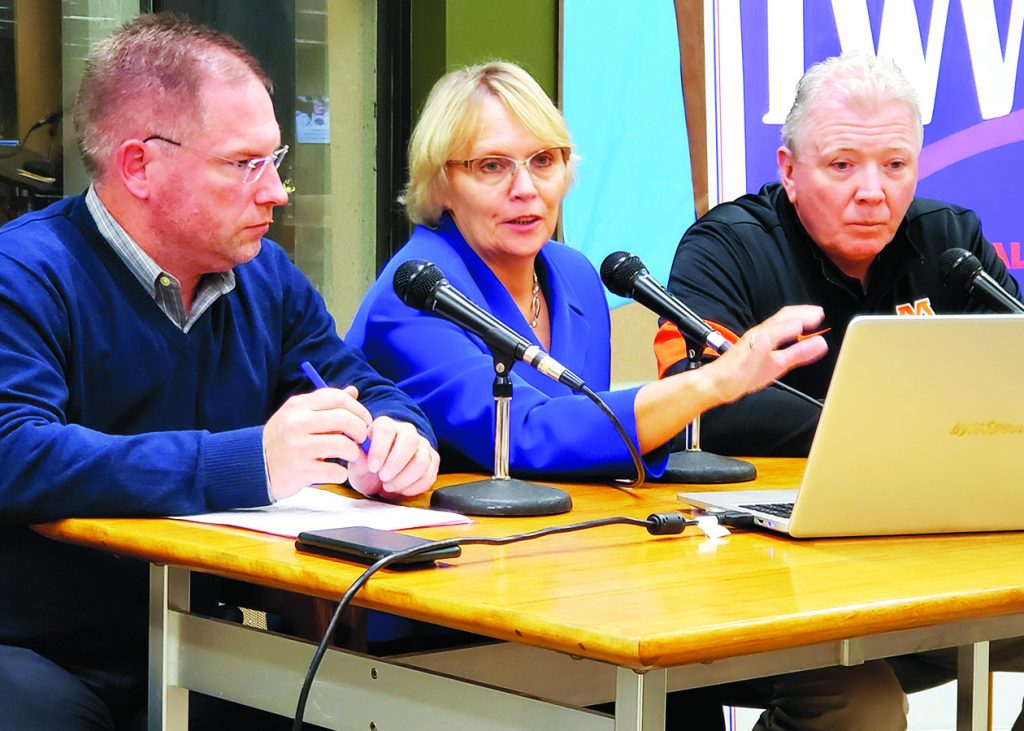
Nancy Edmonds Hanson
hansonnanc@gmail.com
The $110 million school bond referendum that Moorhead voters will decide next month not only insures a quality education for the city’s high school students for generations to come … it will actually cost homeowners less in annual taxes than the much smaller bond they passed with 64% approval back in 2015.
Superintendent Brandon Lunak traced the district’s growing needs and progress in meeting them at a public forum Thursday, Oct. 10, sponsored by the League of Women Voters at the Moorhead Public Library. About 30 residents braved the winter storm to ask him questions about the proposal they’ll decide in a special election Tuesday, Nov. 5. While their questions centered around accessibility, the need to accommodate a fast-growing number of students, energy savings and the present building’s shortcomings, the superintendent brought up financing as well.
Four years ago, voters approved a $78 million bond to deal with elementary school capacity, as well as increased building security. That resulted in the construction of Dorothy Dodds Elementary School and Horizon West, which serves 5th and 6th graders. The bond resulted in an increase of $9 per month on $150,000 homes, $13 on $200,000 homes, and $20 on those valued at $300,000.
Thanks to growth across the community, he said, the impact of the 2019 bond – more than one-third greater than the previous measure – will amount to $5 per month on $150,000 properties, $8 on $200,000, and $13 on $300,000, or 40% less than the smaller 2015 measure.
In addition, farmers concerned about property tax increases will see little to no impact. He explained Minnesota’s School Building Agricultural Credit includes a commitment for a 50% for taxes payable in 2020, rising to 70% in 2023. In addition, he said, the tax impact on commercial and industrial properties will as little as zero, thanks to the Border Cities Disparity Tax Credit.
The three educators pointed to years of conversations with community task forces that led to the decision to rebuild Moorhead High on the same site as the present school, which was built 52 years ago. Not only did the committees and, ultimately, the school board favor one high school over the concept of building a second, new one while remodeling the old school – the decision comes with a far lower price tag, Lunak said, than the construction and operation of two high schools.
“We all carry memories of what Moorhead High was like. We invite you to come in and take a look,” principal Lawrence said, noting that the d50-year-old structure fails to meet modern expectations for secondary education.
Physical shortcomings lead the list, according to the speakers. One is that the facilities are separated into at least a dozen levels, making accessibility difficult – sometimes impossible – for students with mobility issues. Security is a major issue as well, with 26 separate entrances around its perimeter. A large majority of classrooms have no windows and, thus, no natural light. The aging boiler system operates at 50% efficiency, wasting energy and failing to do its job properly. Lawrence noted that students in one classroom might be shivering at 60 degrees, while others just down the hall are sweltering at 80.
The biggest issue of all, Lunak stressed, is that the high school’s capacity is far too small to serve students in classes already in sight. Built for 1,800 students, it has 1,872 enrolled this fall. Projections based on current enrollments put that census at 2,459 in 2023.
Part of the answer is the three-wing, three-story design planned immediately north of the current structure. Another part – “the most exciting,” according to assistant superintendent Uselman – is refitting the old Sam’s Club facility north of Interstate 94 as a visionary career academy. From 300 to 700 students would spend part of their days taking classes ranging from more traditional vocational education – construction, fabrication, welding, auto technology – to health, agricultural, culinary, management, information technology, architecture and robotics.
If the bond issue passes next month, the superintendent sketched out a construction timeline beginning with building parking lots at the high school and developing the Career Academy programs in 2020. The academy will open in 2021, when construction begins on the three classroom wings north of the present high school. That academic space will open in 2023; at the same time, the second phase of construction will replace facilities on the south side of the building. (The Sports Center will not be affected to a large extent.) The entire project will be complete in 2024.
Those attending the forum had one final question for the three educators: What is your favorite part of the proposal?
Lunak cited improved accessibility for all students, regardless of their mobility issues. “Those who use wheels to get around won’t feel isolated when they come to school. They want to be treated like any other student,” he said.
Uselman pointed to the broad involvement of hundreds of community members in planning the new high school. Beyond that, she said, “I’ll be excited beyond belief if we can have a career academy where every kid can explore all of her options.”
Said Lawrence, “When teachers and parents see the other schools around us that have been built in the last quarter century, they just say, ‘Wow!’ This is what our kids deserve.”
Voters can take a firsthand look at the present state of Moorhead High at two open houses at 7 p.m. Thursday, Oct. 17, and Tuesday, Oct. 29. The plans will also be discussed in Lunak’s State of the District session in the Probstfield Center Boardroom at 6 p.m. Thursday, Oct. 24. (RSVPs are requested for the session; call 284-3400 or register online at communityed/moorheadschools.org). More information on the 2019 is available online at moorheadschools.org/2019bond.


